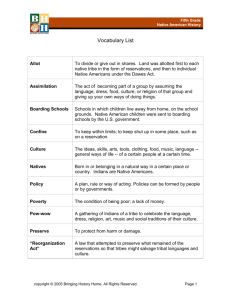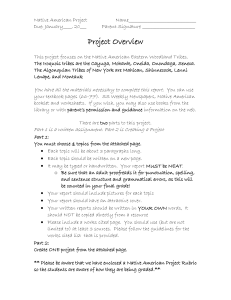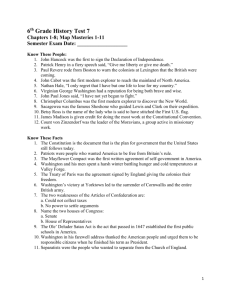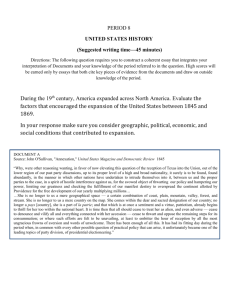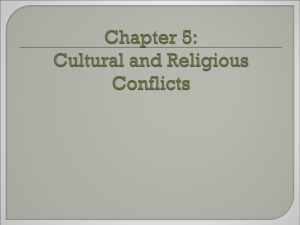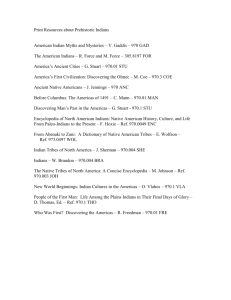Indians of the Winnipesaukee and Pemigewasset Valleys
advertisement
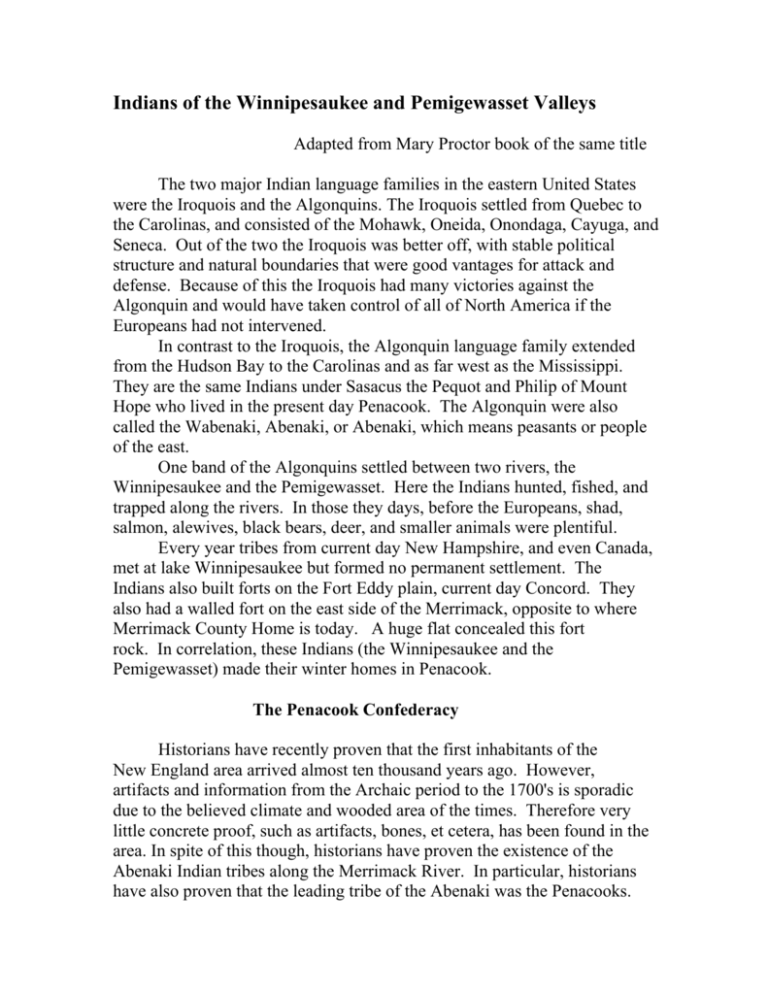
Indians of the Winnipesaukee and Pemigewasset Valleys Adapted from Mary Proctor book of the same title The two major Indian language families in the eastern United States were the Iroquois and the Algonquins. The Iroquois settled from Quebec to the Carolinas, and consisted of the Mohawk, Oneida, Onondaga, Cayuga, and Seneca. Out of the two the Iroquois was better off, with stable political structure and natural boundaries that were good vantages for attack and defense. Because of this the Iroquois had many victories against the Algonquin and would have taken control of all of North America if the Europeans had not intervened. In contrast to the Iroquois, the Algonquin language family extended from the Hudson Bay to the Carolinas and as far west as the Mississippi. They are the same Indians under Sasacus the Pequot and Philip of Mount Hope who lived in the present day Penacook. The Algonquin were also called the Wabenaki, Abenaki, or Abenaki, which means peasants or people of the east. One band of the Algonquins settled between two rivers, the Winnipesaukee and the Pemigewasset. Here the Indians hunted, fished, and trapped along the rivers. In those they days, before the Europeans, shad, salmon, alewives, black bears, deer, and smaller animals were plentiful. Every year tribes from current day New Hampshire, and even Canada, met at lake Winnipesaukee but formed no permanent settlement. The Indians also built forts on the Fort Eddy plain, current day Concord. They also had a walled fort on the east side of the Merrimack, opposite to where Merrimack County Home is today. A huge flat concealed this fort rock. In correlation, these Indians (the Winnipesaukee and the Pemigewasset) made their winter homes in Penacook. The Penacook Confederacy Historians have recently proven that the first inhabitants of the New England area arrived almost ten thousand years ago. However, artifacts and information from the Archaic period to the 1700's is sporadic due to the believed climate and wooded area of the times. Therefore very little concrete proof, such as artifacts, bones, et cetera, has been found in the area. In spite of this though, historians have proven the existence of the Abenaki Indian tribes along the Merrimack River. In particular, historians have also proven that the leading tribe of the Abenaki was the Penacooks. Penacook itself comes from a Massachusetts word, Pennayi meaning crooked and tegua meaning river, making their name Crooked River. This corresponds to their location along the Merrimack River and how they were spread over the Merrimack River, as far north as Lake Winnipesaukee. Each separate tribe was named after the location that they lived in (Winnipesaukee, Ossipee, et cetera). All of these tribes were Penacooks and under the leadership of the Great Sachem. However, since they were spread over such a large area, each tribe had their own chief or sagamore. These two positions, although different, were the same and bound by the same traditions. For starters, the sagamores were elected into their positions by the people and they could by ousted from their position of the tribe suffered from their rule, or they behaved badly. Otherwise, the sagamores held their positions for life, but they had limited authority that stemmed from their hunting skills, bravery in battle, oration skills, and their reputations for honesty, generosity, and wisdom. When a sagamore was lacking in these areas, the customs of the tribe and the public opinion took over and usually 'ruled' for the sagamore. Such was not the case when the English first came to the Merrimack area, up from Massachusetts. At that time, about 1620, the Great Sachem of the Abenaki was Passaconaway or Child of the Bear. At first, Passaconaway was not particularly friendly with the English, but with time he tried. The English however did not try, and once when there were rumors of war they kidnapped Passaconaway’s son Wanolancet, and his wife and small child. They dragged them around Boston with ropes around their necks. For months they held them in prison until the British realized their error and released them. For this, Passaconaway never forgave them. Passaconaway died in 1669 at about 100 years of life. He had at least six children. His son Wanolancet succeeded him, and his other children became sagamores of other areas in New England. Appearance The Penacook Indians had were tall, muscular, and well portioned with high prominent cheekbones, small dark eyes, and strong teeth. They were light tawny in color with straight black hair. They usually wore their hair closely cropped to the head, but their hairstyles were left to the wearer's imagination except for the scalp lock, which was grown as long as possible. They used a daily dressing of bear fat to give their hair a dark sheen, and sometimes they added soot to darken its color. No Penacook boy was allowed to let his hair grow long until he reached maturity at the age of sixteen. A bearded face was uncommon on a Penacook Indian since they would pluck out any hairs as soon as they appeared. Instead, they would paint their skins with red paints from iron pigments. They also protected their bodies from insects and cold by using bear grease. They would use aromatic plants, like burning sage, for a better smelling body. Some Indians created tattoos by using a sharp stone, a bone sliver, and a black dye. On occasion they went one step further and burned the design into their skin. The Penacook women were slender in build. The wore their black hair very long and sometimes they wore it in a bunch like a beaver tail. their skin was kept smooth with fish oil and fat from an eagle. As the men did, the women also applied red paint to their faces, and sometimes they would use a black pigment around their eyes and forehead for ceremonial purposes. Jobs and Clothing The Penacook women were said to have all the drudge work in the family circle. The husband would do all the hunting and fishing, and the wife would cultivate the land, build the wigwam, and supply all the food and water the family needed. Still, the Indian woman found time for beading and braiding grasses, willows, shells, a feather ornaments. They created unusual patterns and designs with porcupine quills. Since they had all the responsibility of making the family clothing, they became experts at tanning animal hides. They would shape the garments with stone knives and bone needles were made from the ankle of the deer. Their thread came from the muscle of the deer, or sometimes-vegetable fiber. It was a difficult process. The Indian everyday clothing was simple. Before the settlers came men wore breechclouts during the warmer weather. They would fashion mantles or shoulder capes that were fastened at the left shoulder. The right shoulder was bare for better movement. Then the mantle was secured at the waist with a hollow belt. The belt carried a supply of dried corn or pemmican for long trips. The cold weather mantles were made of deer, moose, raccoon, et cetera. The women wore knee length skirts made of a rectangular piece of deerskin. Their mantles were longer and fuller. It would usually take two pieces of deer or bearskin sewed together at the sides. Sometimes they made a jacket as an upper covering. Both men and women wore leggings to protect themselves from brush, the cold, and for ceremonial purposes. However, the men were usually longer then the women and tied into the moccasins, but the women began just below the knee and were also tied to the moccasins. Men and women both had the responsibility of collecting the wampum. Wampum was used for decoration, especially with ceremonial clothing, and was cut from white or black seashells, or hollowed pieces of wood and bone. Strings of wampum was placed around their necks and/or used as belts. One sachem's belt was said to be nine inches thick and fell below his waist. They would use the wampum belt as a record of their tribes traditions and ancestors. When the Europeans came they were said to use the wampum as money then a personal decoration. It was used for ceremonial – to seal a deal. Homes The Indians of this area used two types of shelter: the temporary and regular wigwam. Since the Penacooks moved with the seasons the temporary wigwam was generally used for short term shelter and resembled the tipi of the plains, but it was not one. White birch strips were sewn together along their widest parts forming mats that were easily carried to other areas. The structure of the wigwam was made of small trees bent and twisted together before they were covered with the mats of birch or other mats made of skins. They were small, but they were dry and warm. In the winter, the wigwam was a tight fitted warm comfortable dwelling that resembled a longhouse. Like a longhouse, the winter wigwam could house all generations of a family and just that little bit more. To place the wigwams and position them the man would first mark out a circle around 10-16 feet in diameter. Then the woman would find saplings and bent them over in a pattern similar to the igloo shape. Two exits were made, each of them about three feet high. During the winter they would need to build fires in the center of the wigwam, so they would make an opening about 18 inches wide at the top of the wigwam for the smoke to escape. Then the wigwam was complete. They had little furniture. Their mats were used for bed coverings, sitting, et cetera, and were made of cornhusks, bulrushes, or Indian hemp. These mats were woven together, not sewn. For bed coverings they would also use animal skins, and sometimes, if the wigwam was big enough, they would make raised platforms attached to the sides of the wigwam, similar to an army cot. They didn't use stools or chairs, but rather sat on the ground with their elbows resting on their knees. When the wigwam became too soiled and smelly, they would move and construct a new one. They had a few wooden or clay bowls, and some stone implements to use for cooking. Early Indians made coil clay bowls and then abandoned them for other things when they came in contact with European settlers. However, they did make birch-bark, rectangular containers used for cooking and during the maple syrup time. The Penacook would only eat when they were hungry and had no set times for meals. Transportation The Penacook had three methods of transportation: the canoe, Dugout, and their own two feet. The canoe was usually made of white cedar where the frame was soaked in boiling water and dried to give it its upward bow shape. Stakes were set out in the canoe pattern, and then strips of bark from the white cedar where cut to a certain size and thickness by a stone blade. After being soaked, the pieces of bark were laid out flat and then bent around the frame. They were bound and held together by fibrous roots and animal muscle sewn with a bone awl. Extra bark was sewn to the sides of the canoe for the proper height and weight so that it would not tip over easily. Finally, the canoes were waterproofed with a combination of pitch and grease. Sometimes they would make a sail made of deerskins for lake or pond traveling. When done, the canoe would carry great loads, three or four people, and still be able to be carried across land by one person. In the winter the Indians would sink the canoe with rocks and store it under the water. Then in the spring, after a thaw, they would still be able to use it again. The second method of transportation was the dugout. They were about a foot-and-a-half to two feet wide and about twenty feet long. They could hold from ten to thirty people, depending on the size of the tree. With the help of fires and stone axes, they would cut down a huge tree. The branches and bark were then burned (if the fire got out of hand the would use water to put it out) or stripped off, and the log was placed on supports. The Penacook would split the log with wedges, burn it and gouge out the wood until it was hollow. They would make the sides and bottom as thin as possible so it would float and be safe, and their bow and stern were blunt, not pointed. *An example of a one hundred year old, twenty-foot dugout was found in a Hopkinton lake in 1916 or -17. There are samples on display in local museums. Their final method of transportation was their own two feet. They could travel great distances with little or no preparation, and were usually good distance runners. Tools and Weapons All of their tools were made of bones, wood, shells, or stone. Their hoe was a stick fitted with a clamshell or triangular shaped rock. Their ax was a stone with a wooden handle attached to the neck by a willow branch or other wood twine. The first mortars and pestles were made of wood or naturally made stone bowls (glacier potholes) and rocks. The Indians used their natural resources to create what they needed. They took only what they needed, nothing more and nothing less. Their weapons of war were the bow and arrow, spear, and tomahawk. The string of the bow was made of either Indian hemp or animal muscle. The arrow point was a sharp stone, deer horn, or an eagle claw. The tomahawk was merely a stick, two or three feet in length, headed with a knob or stone, and the spear was a stick with a sharpened point. During this time tribes lived in fear of constant attack from other hostile tribes, and later from the Europeans. Young Penacooks could not participate in the war dance until they were sixteen, and consequently not the battles either. When they were sixteen they had to prove themselves. They would be sent off in the middle of winter with a bow and arrow, hatchet and a knife to survive on their own. If they came back in good shape they were accepted and allowed to participate in the war dance. The war dance itself had religious significance and symbolism. The sachem had to inspire the males to volunteer their services in battle. A Drumbeat would incite and lead the tribe into frenzy where afterwards the warriors would travel at night and not attack until dawn. Tribes stressed a great deal on bravery, and to be considered a coward was the worst insult to a Penacook. The children of the tribe were raised with long fasts to get used to this for when they had to travel long differences. However the Europeans saw this as being cruel and too rigid, but that was not so. The children were taught with games and stories on how to survive on their own making their learning experience far from rigid. Entertainment The Penacook had a game, which resembles modern cricket or Lacrosse, and playing ball and pitching Quoits were favorites among all members of the tribe. The had war dances, a planting dance, strawberry feast, the Dance of the Green Corn, and in this area the Eel dance. When the eels came up the rivers from the sea in great numbers, the tribes had a dance to give thanks and celebrate. Some early white settlers had to adopt themselves to this custom. Medicine Man The medicine man, powwaw, or shaman, was a man of great importance in the tribe. He would treat some of the more serious illnesses since the women generally took care of the smaller ones, prepare the tribesmen for the after life, and was considered a magician. Every man had his own medicine bag made from the skin of a small animal and in the form of a pouch or pocket. Inside it they carried a strange mixture of things that suited themselves or their personalities. However, they all had a tooth, bone, claw, stone, and a totem or symbol of their tribe. Language Native Americans in the northwest were part of the Algonquin dialect tribes that stretched from the Carolinas to the Canada (north of the Great Lakes) and to the Plains. The spoken language was almost completely lost to the assimilation of the Penacooks to French Canadian and disease. The Penacooks had no written language until the Europeans came. Because of this they could only trace their history back only two or three generations. A lot of what is know is based on what has been gathered from the artifacts that were left behind, as well as journals, letters, and official papers of the European explorers and settlers. However, most of the names chosen by the clergy for the Indians were usually bad names that the Indians would call their enemies. Later on the French missionaries wrote down the Abenaki language and some of the Indian language was lost in the translation. There is currently an Abenaki dictionary and language book and tape to revise the language. The words below supposedly represent the language of the native people who lived in the Franklin area. Kisosalakussenamaskemezinolkaawasos- sun, moon, month a star stone oak deer bear
